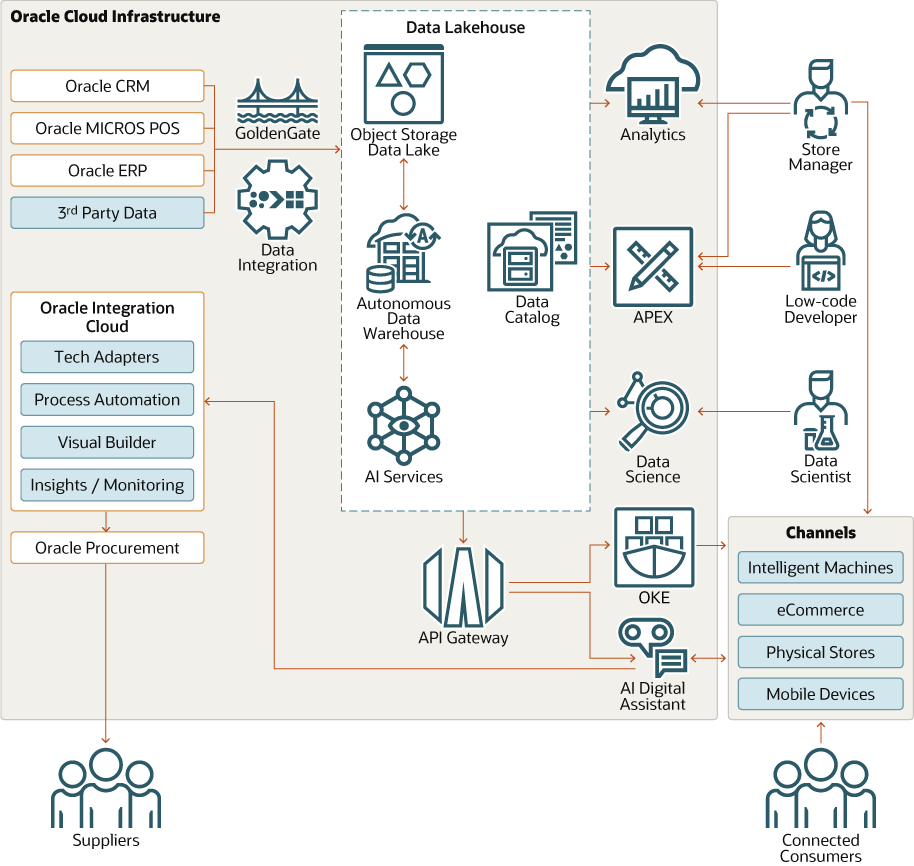When the pandemic hit and the entire world went on lockdown, the consumers’ ability to shop in physical stores was dramatically affected. Most retailers threw out their playbooks and adapted. Consumers also adapted, fueling a shift in consumer behavior, perceptions, and expectations.
Oracle examined changes in consumer shopping habits in grocery and found that 92% of consumers surveyed plan to continue online grocery shopping in the future, with 7 in 10 consumers anticipating shopping online as much as or more frequently than they have during the pandemic. The research also showed that 47% of global respondents said that out-of-stock merchandise topped their list for a bad shopping experience. Beyond product availability, consumers also expect their time in-store to be brief and efficient.
Now, more than ever, retailers must provide a seamless shopping experience and the key element to making that happen is data.
Aggregate retail data for real-time stock visibility
Retailers, grocers, and restaurants are capturing a wealth of data, and many are turning to cloud-based big data solutions to aggregate and manage data. In a recent proof of concept, Oracle cloud engineering demonstrated how to maximize value of Oracle applications by architecting a data lake house to capture, manage, and gain insight from data produced from point of sale, inventory, customer, and operational systems to understand real-time inventory availability.
In the Oracle Architecture Center, you can find a detailed reference architecture that introduces a platform topology, a component overview, and recommended best practices for architecting a data lake house for retail inventory analytics. The architecture explores using a comprehensive set of data and analytics capabilities to ensure that accurate inventory is displayed across all shopping channels and internal dashboards used by store managers. For example, if the customer is purchasing through a mobile application, they can have confidence that the product is there when they arrive. For the store manager, they can quickly view available and reserved inventory or even top trending products and adjust as needed.
Get started with big data in retail
Understanding real-time inventory availability is one use case for setting up a data lake house. Retailers can also use big data in a lake house to drive data-driven insights and apply learnings to improve business decisions, such as optimizing pricing, increasing the speed and ability to update product assortment, forecasting product demand, detecting fraud, or even personalizing marketing promotions for loyal customers.
With a data lake house engineered on Oracle Cloud Infrastructure (OCI), retailers can analyze or build ML models using large volumes of diverse data, structured and unstructured, from various sources. It all starts by combining the flexibility and relatively low cost of a data lake with the ease of access and enterprise capabilities found with data warehouses. You can use OCI native services to get started in the following ways:
-
Store data: A data lake is the foundation for retail analytics. By implementing a data lake using OCI Object Storage service, retailers can quickly ingest raw data (streaming or API), batch process, or replicate data from nearly any system that generates information, including semi-structured and unstructured sources, such as images or videos. Object Storage provides virtually unlimited scale. Because metadata is stored with the object, lookups are much quicker and more efficient. Data Flow, a serverless Spark service, enables our users to process extremely large data sets in Object Storage without having to deploy and manage Spark clusters. You can also build a new open source data lake using Big Data service for a scalable Hadoop-based environment. Meanwhile, data warehouses like Autonomous Data Warehouse and MySQL Heatwave are optimized to ingest and store structured data.
-
Create metadata: When data is stored in the data lake, use Data Catalog to harvest and manage metadata from data sources across OCI data stores and even on-premises. This availability helps users easily find the data that they need for analytics.
-
Analyze data: Retailers can run advanced analytics, apply models, and visualize data using Oracle Analytics Cloud or using their own analytical tools of choice, such as Microsoft Power BI, Qlik, or Tableau.
A complete cloud infrastructure platform for retailers
Oracle offers a comprehensive portfolio of cloud services for any retail workload, from cloud native applications to high-volume enterprise workloads. Retailers can build new applications, extend existing ones, or bring enterprise applications to the cloud with minimal refactoring or rewrites. They can also run applications and databases more economically and with the performance, resiliency, and security that enterprises need. Retailers working with Oracle to adopt a cloud-first strategy are supported by the most complete, integrated suite of enterprise applications, the connected architecture for retail operations, and superior cloud economics.
Looking to adapt, innovate, and stay resilient? Learn why retailers trust OCI with their most demanding workloads.

